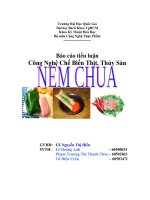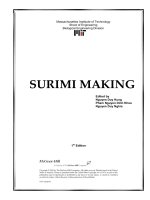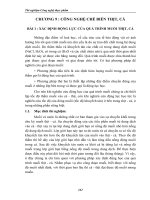Công nghệ chế biến thịt gia cầm (POULTRY MEAT PROCESSING)
Bạn đang xem bản rút gọn của tài liệu. Xem và tải ngay bản đầy đủ của tài liệu tại đây (1.01 MB, 34 trang )
VINH UNIVERSITY
FACULTY OF CHEMISTRY
POULTRY MEAT PROCESSING
PRESENTERS: LE THI MY CHAU
This book has 18 chapters,
contents:
Chapter 1: Introduction to poultry meat
processing
Chapter 2: Prelaughter factors affecting
poultry meat quality
Chapter 3: First processing laughter
through chilling
Chapter 4: Second processing parts,
deboning, and portion control
Chapter 5: Poultry meating inspection and
grading
Chapter 6: Packaging
Chapter 7: Meat quality: Sensory and
instrumental evaluations
Chapter 8: Microbiological pathogens: Live
Poultry considerations
Chapter 9: Poultry-borne pathogens: plant
consideration
Chapter 10: Spoilage bacteria associated
with poultry
Chaper 11: Functional properties of muscle
proteins in processed poultry product
Chapter 12: Formed and emulsion products
Chapter 13: Coated poultry products
Chapter 14: Mechanical separation of poultry
meat and its use in products
Chapter 15: Marination, cooking and curing
of poultry products
Chapter 16: A brief introduction to some of
the practical aspects of the Kosher and Halal
Laws for the poultry industry
Chapter 17: Processing water and
wastewater
Chapter 18: Quality assurance and process
control
Chapter 1: Introduction to
poultry meat processing
-
-
Poultry processing is a complex
combination of biology, chemistry,
engineering, marketing and
economics
While producing human food is the
main goal of poultry processing,
related fields include waste
management, non-food uses of
poultry and pet/livestock feeds
Chapter 1: Introduction to
poultry meat processing
- Commercial poultry is extremely
uniform in appearance and
composition. Tightly managed
breeding, incubation, rearing and
nutritional regimes created a bird
that is a virtual copy of its siblings
Chapter 1: Introduction to
poultry meat processing
The poultry industry is rapidly
becoming global. A growing
precentage of the US poultry industry
revenuea come from exports of
poultry products, particulary the ones
such as dark meat and feet that do
not have strong markets in the US
As a result, the industry in the US has
become keenly aware of the politics and
economics of its major customer coutries;
Russia, Hong Kong, Japan, Canada, and
Mexico
Although the US is the world leader in
poultry production, its industry is still
concerned about conditions and any
developments in poultry-producing nations
with which it competes
Economic production through vertical
integration, favorable meat
characteristics, and product innovations to
meet consumer needs have all contributed
to the poultry industry’s success
However, the safety of poultry products
and the use of water in processing are two
issues with which the industry is
concerned
Developments in live bird production,
processing plant operations, product
characteristics, and inspection
systems are all being made to reduce
bacterial contamination on the
product and improve the product’s
safety.
Likewise, the expense and environmental
impact of using large quanlities of water
in processing and then cleaning that
water before discharging it have all
prompted intense study in these areas
The following chapters will provide the
reader with an understanding of these
and the many other areas involved in
poultry meat processing
-
-
Chapter 2: Preslaughter
factors affecting poultry
meat quality
Poultry production and processing
involve a series of interelated steps
designed to convert domestic birds into
ready-to-cook whole carcasses cut-up
carcass parts, or various forms of
deboned meat products
Antemortem factors affecting quality:
+ harvesting
+ feed withdrawal
Typical commercial broiler house
Chapter 2: Preslaughter
factors affecting poultry meat
quality
+ carcass contamination
+ feed withdrawal and
microbiological implications
+ live shrink and carcass yield
+ injuries associated with
catching and cooping
- Poultry meat quality is affected by
numerous antemortem factors, in
particular those occurring during the
last 24 hours that the bird is alive
Chapter 2: Preslaughter
factors affecting poultry meat
quality
-
-
These short term factors influence
carcass yield (live shrink), carcass
defects (bruising, broken/ dislocated
bones), carcass microbiological
contamination, and muscle metabolic
capabilities
There is even evidence to suggest that
stressful conditions during harverting,
such as catching and cooping, affect the
postmortem muscle functional properties
Chapter 2: Preslaughter
factors affecting poultry meat
quality
Poultry meat quality is affected by
numerous antemortem factor, in
particular those occurring during the
last 24 hours that the bird is alive.
These short term factors influence
carcass yield (live shrink), carcass
defects (bruising, broken/ dislocated
bones)
Chapter 2: Preslaughter
factors affecting poultry meat
quality
There is even evidence to suggest that
stressful conditions during harvesting,
such as catching and cooping, affect the
postmortem muscle functional
properties
Current issue associated with foodborne illnesses have force poultry
companies to pay even more attention
to live production than before to satisfy
the “farm-to-table” food safety initiative
Chapter 3: First processing
slaughter through chilling
Slaughter:
+ Unloading
+ Stunning
+ Killing
+ feather removal
+ evisceration
- Chilling
-
Chapter 3: First processing
slaughter through chilling
-
-
The processing plant is a highly
coordinated system of mechanized
operations that kill the birds, remove the
inedible portions of the carcasses, and
package/preserve the edible portions of the
carcass for distribution to the consumer
Another important factor is the logistical
coordination of carcass flow and production
lines so that adequate birds are present to
make maximum use of the personnel and
equipment
First processing is critical in the
processing plant because it involves the
conversion of a living animal to inanimate
tissue. The physiological responses on the
animal and its living tissues are important
to maintaining product quality
In addition, to product quality, an
overriding theme in processing is the
maintenance of product yield, usually
interpreted as minimizing losses
Such losses can be in the form of worker
productivity with an empty shackle or missed
assignment, excessive or unnecessary
trimming, or maladjusted equipment making
improper cuts. Because first processing is
the common funnel in the conversion of live
poultry into the variety of products we see in
the marketplace, it is critical that all the
steps from slaughter through chilling be
done correctly and efficiently
Chapter 4: Second processing:
parts, deboning and portion
control
-
-
Once birds have been converted into
processed carcasses and chilled to the
required temperature, they can be
packaged and marketed whole or they
can be converted into some other form
such as parts or boneless meat
The many possibilities that exist for a
carcass beyond the chiller are grouped
together under the area of the plant
known as “second processing”
Chapter 4: Second processing:
parts, deboning and portion
control
- Cutting the carcass into parts, deboning
meat, and portion control sizing are
functions that the poultry industry has
begin to do in an effort to save the
customer (home consumer, restaurant
chain or supermarket time). Processors
realized that customers were willing to
pay for these services, so it has become
a major effort in most companies









